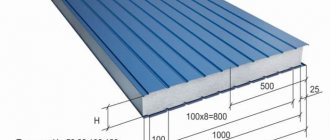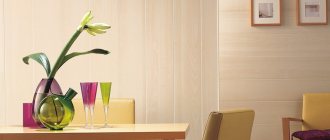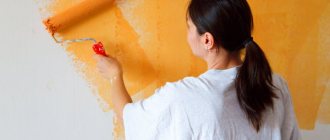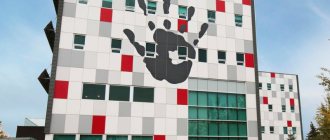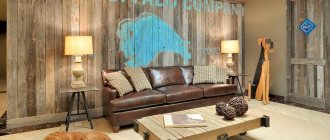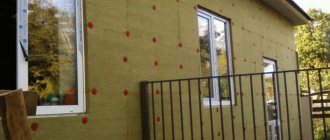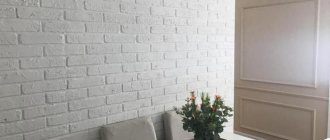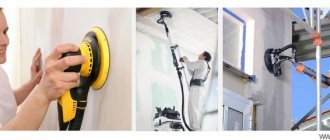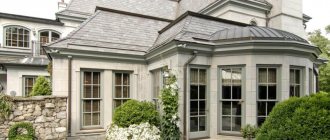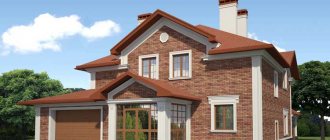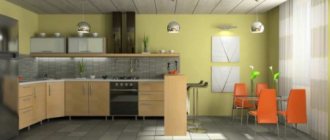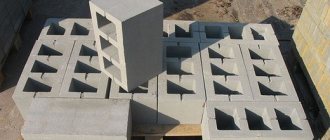Facade panels made of polyvinyl chloride
This is a beautiful, convenient solution - they attach easily, like a construction set, protect the house from moisture and precipitation, protect heat, and create a unique design. There are many of them - made of metal, stone, vinyl, glass. Made of cement and wood, finished to look like brick, like wood, suitable for plastering.
Original color for finishing
But in order for all the benefits to appear, you need to cover the house not with any panels, but with those that are best suited for it. They must be made of suitable material first of all.
Polyvinyl chloride (aka PVC) is the most common material for panels. Its main characteristic is its low price - the mortgage for the cladding of the house may be small.
Beautiful, convenient solution
PVC has advantages:
- Variety . Like any plastic, PVC can be given any color or texture. Patterned panels, panels made to resemble natural wood or stone, brick or glass, multi-colored and with patterns - among PVC there are panels to suit every taste. With their help, you can make any design without thinking about the fact that the wood is rotting, or the stone is too heavy - just choose a good imitation.
- Lightness . PVC is the lightest existing material. This is a big plus, since even the thinnest walls will support its weight and no calculations are required. In addition, you can deliver purchased PVC panels home by your own car, on your own.
- Sustainability . They are not afraid of water, biological irritants, mechanical influences, and retain their original shape well. They cannot be damaged by rodents and parasites, they do not melt in the heat (unless you buy a low-quality segment), and do not require care.
- Easy installation . Due to the weight and ease of fastening, even a person who has never tried to do repairs can handle PVC. And if something doesn’t work out - or if the panel is damaged later - it can always be replaced with another one of the same kind. This will not cause much damage to the budget.
Polyvinyl chloride (aka PVC) is the most common material for panels
PVC is also characterized by durability - some manufacturers promise that their panels will last half a century, or even longer. This, however, is only possible under good weather conditions and the absence of mechanical influences.
The advantages are balanced by the disadvantages:
- Thermal expansion . Installed panels over time, under the influence of heat, can expand and go in waves, completely destroying the entire design. But this behavior is typical for low quality PVC.
- Lack of frost resistance . In the cold, PVC becomes brittle; a slight blow can break or bend it, so installation in the cold is not recommended, and in winter it is better to be careful.
- Lack of fire resistance . In the event of a fire, the panels will not catch fire, but will begin to melt and smoke.
PVC is characterized by durability
Insulating material must be attached under the PVC, otherwise the thermal insulation performance will be low.
There are two subtypes of PVC facade panels:
- Classic . The width is thirty to forty centimeters, the length is from three to four meters. It is most often laid horizontally, since when installing vertically it has to be trimmed, it imitates wood in most cases, although metal is also found.
- Basement . With the same width, it is up to a meter long, which allows it to be laid both vertically and horizontally. It is supposed to be more reliable, but in reality a short bar is easier to replace than a long bar if something happens to it. Most often it imitates natural stone or brick.
PVC is installed from the bottom up, from the foundation to the roof.
In the cold, PVC becomes brittle; a slight blow can break or bend it
Advice In appearance, PVC panels are difficult to distinguish from the material they imitate, especially from afar. Therefore, if you are satisfied with their properties, natural material can be replaced with them.
Finishing options
The differences between finishing panels lie not only in what material they are made of. Among them we can also note:
- size;
- fastening method;
- imitation of any material;
- presence of thermal insulation;
- panel shape.
Some trim panels may be narrow but long enough. Others are made in the shape of rectangles or squares. Finishing panels can be fixed to each other using a locking mechanism or overlapped. The outer layer of some types of cladding is modeled after natural stone or brick. Some types of finishing material may contain insulation, so you do not have to purchase it additionally.
Metal
They are very popular among customers. Such panels are made from a base that is resistant to corrosion. This is important because they are constantly exposed to weather factors. Aluminum or galvanized steel is most often used. The positive aspects of this finishing material include:
- relatively light weight;
- resistance to open fire;
- resistance to temperature changes;
- minimal linear expansion;
- resistance to physical influences;
- high reliability.
Facade panels for finishing a house, which are made of metal, have a small thickness. This has a positive effect on their weight. They can come in a wide variety of shapes, but more often they come in rectangular and square configurations. Metal perfectly resists fire. In the event of a fire, such panels will not support combustion and will not collapse from exposure to temperature. Facade panels of this type perfectly tolerate both sub-zero and high temperatures. At the same time, they do not have a large linear expansion, which would lead to their deformation and loss of appearance.
Regarding the disadvantages of such a material, it is worth mentioning the possibility of corrosion processes when damaged (does not apply to aluminum), as well as the lack of thermal insulation properties without the use of additional insulation. Metal tends to accumulate static electricity, so such panels must be grounded to avoid shocking those who touch them. Siding is made from metal. In appearance, it can be finished to resemble wood or another surface. An example can be seen in the photo below.
Plastic
It is this material that is now gaining the greatest popularity. This is due to the availability of panels, as well as the large number of positive aspects that such panels have for finishing the facades of a house. Most often, the basis for plastic panels is polyvinyl chloride or PVC. Among the advantages it is worth noting:
- high speed of material installation;
- UV resistance;
- light weight;
- long term in any weather conditions;
- large selection of material shades;
- ease of care;
- wide choice of material forms.
PVC is an environmentally friendly material, so you don’t have to worry about your house being filled with harmful emissions. The buyer can choose a huge number of shapes and sizes of plastic panels. In appearance, they can be made to look like stone, wood, brick, tile, and so on. During production, various pigments can be added to PVC plastic, which give the panels a unique color. Some types are suitable for self-staining. It is very convenient to install such elements. They are light in weight, so no special equipment is required to lift them to a height. Caring for such finishing components is quite simple. Simply wash them with a hose using shampoo or soap.
Among the shortcomings, one can note a certain fragility of products from frivolous manufacturers. Another type of plastic finishing elements are panels using polyester fiberglass. They have high strength and long service life. They are often made with an imitation of natural stone. It can be distinguished from natural only upon close examination. Another type of plastic, which is also used for facade panels, is polypropylene. Such elements are made by casting. The Alta-Profile company, for example, produces such solutions. An example of their products is in the photo below.
Fiber cement
Fiber cement is an interesting and in some respects innovative material. It combines the stability of cement and the strength of the fibers added to it. The latter is cellulose. It can be called a stabilizer. If you make a plank of small thickness from cement, it will crumble very quickly and it will simply be impossible to install it. The added fiber prevents this from happening. Facade elements made of fiber cement can be made in a variety of shapes, sizes, and also with imitation of natural and artificial building materials, as can be seen in the photo. Among the advantages of this solution are:
- non-flammability of the material;
- UV resistance;
- long service life of the material;
- relatively light weight;
- additional insulating properties;
- resistance to mechanical stress;
- has no harmful emissions;
- nice appearance of the material.
Fiber cement does not burn, so you don’t have to worry about fire safety. From high temperatures it can simply crack, but nothing more. Thanks to its unique structure, it remains resistant to ultraviolet radiation. This preserves its original appearance throughout its entire service life. Elements made of fiber cement have additional sound and noise insulation. The material is made from natural ingredients, so you don’t have to worry that it can harm the child’s health. There are no restrictions on air temperature or time of year for installing such panels.
Clinker
Clinker panels for facade finishing can also be called an environmentally friendly material. The facing for such elements is clinker tiles. It is made by sintering from a special type of clay. The shade turns out to be very delicate and attractive. The technology for producing such material has been known for quite some time, but does not lose its relevance. The tile itself cannot boast of good thermal insulation properties, so the panels include insulation, which guarantees additional sound insulation. If the choice falls on these panels, then you will be able to experience their advantages from your own experience:
- high strength of the material;
- ease of installation;
- high speed of material finishing;
- large selection of shades;
- resistance of the material to weather factors;
- long service life.
After finishing the walls with such panels, the house acquires a beautiful appearance similar to that obtained after using facing bricks, this is clearly visible in the photo. After heavy rains, there is no white salt residue left on the tiles, which is quite difficult to wash off. Clinker can be used for finishing the basement level, as it has good strength and resistance to physical influences. Such elements are most often attached to the wall using dowels and screws. They fit together in such a way that it is almost impossible to find a seam.
Sip panels
Sip panel can hardly be called an ideal finishing material. This is due to the fact that it is based on an OSB board, which looks like an untreated rough surface. To a greater extent, such elements are used to insulate walls or for the construction of frame houses. But their use evokes only positive emotions. In the future, they can be painted or covered with one of the types of siding. Honest manufacturers try to adhere to all compliance standards, without adding harmful substances to bind wood chips. Therefore, you should only buy such items from trusted sellers. Their thickness can exceed 20 cm, which will be an excellent solution for cold regions. The manufacturing process can be assessed in the video.
Wooden
In the case of a country house that is located in or near a forest, you want it to look as harmonious as possible. Wooden panels for external decoration of facades are perfect for these purposes. On the one hand, it is an environmentally friendly material that has pleasant tactile properties and does not require imitation. On the other hand, wood is quite demanding in terms of care and maintenance. Periodically it will need to be treated with antiseptic compounds and varnished. Only in this case will it last quite a long time. Wood panels will give the house additional insulation from noise and cold. Such panels can be a block house or other variations. There are no restrictions on shape and design. Everything will depend on the skill of the manufacturer.
Sandwich panels
Sandwich panels can not only give an old building a fresh appearance, but also immediately insulate it. The outer side of such a panel can be corrugated sheeting, after which insulation is placed and another part covers the entire pie. Such panels for facades have excellent strength and can be made with various patterns. By size, you can purchase panels that will be ideal for a specific project. Sandwich panels perfectly protect a building from moisture, since they themselves are not able to absorb or transmit it. They can be installed directly on the wall, without additional lathing, as can be seen in the photo. Another positive property of such panels for home decoration is interchangeability. If one panel is damaged, you will not have to dismantle the entire cladding, but rather only remove one element.
Compositional
Each wall can be turned into a work of art if desired. Composite panels are designed to help with this. They can be made from a variety of materials, as discussed above. The main idea is to realize the architect's idea. Such panels can be made to order, for a specific building. The panels convey a play of color and light or have a unique relief that conveys a special mood. Color solutions can also be very diverse. There are no palette restrictions. It is worth noting that their cost can be quite high, but the result exceeds all expectations.
Polyurethane
Polyurethane has unique insulating characteristics, so panels based on it are ready to insulate walls. Its structure is cellular material, which contains a large number of air bubbles, up to 97%. This is precisely what explains its unique properties. Polyurethane is environmentally friendly, so there are no restrictions on its use. To give panels made of this material strength, the front layer is covered with chips of natural stone, such as marble. But it is pre-immersed in polymer to increase its service life. When choosing such panels, it is worth considering that they can partially deform when exposed to temperatures, therefore, when installing the panels, thermal joints are provided for these purposes. Thanks to the outer layer of natural stone panels, they are sufficiently resistant to ultraviolet radiation. The service life of such facade panels can reach 50 years.
Made of wood
Wooden facade panels are made either from lining or plank. Despite the fact that both are boards, they have specific features that affect the design and the nuances of operation.
Option for decorating a house with wood
Lining is a thin board with a convex surface. It has grooves on both sides with which one strip is attached to the other. It is usually made from inexpensive types of wood, most often coniferous.
The advantages are as follows:
- Easy to install . It is no more difficult to assemble than PVC - the same “insert a tenon into the groove, latches, repeat” construction kit.
- Natural material . This is more a matter of aesthetics than anything else - the lining looks like natural wood. The pattern of the bark is always different, as is the shade of color.
- Environmental friendliness . The material is breathable and does not emit any harmful fumes.
- Low price . Lining costs only a little more than PVC.
Wooden facade panels are made either from lining or planken
But like most natural wood, lining is not stable. It rots and swells from moisture. Dry heat causes it to dry out and crack. It can be damaged by parasites, and moss can grow on it . To avoid this, you need to update the special composition covering the façade from time to time (preferably every spring).
There are no such problems with planken. It is the same board, but with a smooth surface and without any grooves. Its edges are either straight or beveled, and the thickness is usually around two centimeters. They are most often made from larch - a relatively expensive tree, but resistant to moisture.
The advantages are as follows:
- Sustainability . Unlike lining, it does not dry out in the heat and does not suffer from humidity.
- Interesting fastening system . Not only does it provide ventilation, but it also allows you to add a finishing touch to the overall design.
- Beauty . Like any natural wood, planken is beautiful.
- Easy to replace elements . Although the installation itself requires more skill than in the case of lining, it is easier to replace a damaged element - you just need to unscrew it, rather than remove it from the groove system.
Wood is one of the most beautiful and expensive materials
Its main disadvantage is its high price. For larch, which is also impregnated with special compounds at the production stage, you need to pay more than for pine.
Interestingly, in the absence of groove fastening, the planken can be fastened in two ways:
- Visible . In this case, the board scrolls through, straight to the facade. Self-tapping screw caps can be a small but interesting touch to the design.
- Hidden . In this case, the board is attached to a special device attached to the facade - from the outside it seems that nothing is holding it.
Installation of this material requires great skill
Both lining and plank are flammable - if there is a fire in the house, the facade will also burn.
Advice Wood is a beautiful material, but rather impractical (or expensive). It makes sense to install it only if you want wooden panels and no others.
Made of metal
Metal is a relatively expensive material, the price of which directly determines the quality of the resulting facade. Has the following advantages:
- Lightness . Of course, the metal weighs more than PVC, but it is still light enough to be easily delivered.
- Durability . Unlike PVC and lining, metal will not be damaged by mechanical influences - it is difficult to break it or make a hole. It might just leave a small dent, but it can be straightened out.
- Sustainability . The metal is resistant to fire, biological irritants, and temperature changes. It does not change from the heat, does not become brittle in the cold. Pests cannot harm it.
- Moisture resistance . It is provided either by stainless steel or by a special coating. The second is cheaper, but also more fragile - if the coating is damaged, the metal underneath will quickly rust.
- Aesthetics . Metal comes in different colors, but it is always beautiful, has a specific shine, and a special charm. Available in different colors, it can even have a mirror surface.
Metal is a relatively expensive material
Of course, it has disadvantages:
- Noise . If you install the panels horizontally, at a slight angle, every time it rains, the drops will drum on them, creating a loud, annoying sound.
- Difficulty in installation . The metal is most often welded into a single sheet - this way it becomes insensitive to any influences at all, but the procedure requires equipment and skills that you most likely do not have. In addition, after completion of the work, it will be difficult to replace one failed panel. And even if the panels are installed with screws, holes will need to be drilled for them, which also requires skill.
It is imperative to lay a layer of thermal insulation under the metal . If wood can do without it, then metal cannot. It also accumulates static electricity, so attaching satellite dishes and air conditioners to such a façade is a bad idea.
Has a specific shine and special charm
Advice: Metal should be used to cover the facade if it goes well with the architecture of the house. The effect of its use is usually very severe.
Made from fiber cement
Fiber cement differs from ordinary cement mainly in the processing method: it is first mixed, then passed through special holes under high pressure, forming the panels directly. Then they let it sit for several hours, bake it at high temperature and cover it with compounds to repel moisture, coupled with general strengthening.
The resulting panels can look like any material and have the following advantages:
- Sustainability . They do not burn, do not rot, are not afraid of biological threats, do not suffer from heat or cold, and do not change color in the sun.
- Lightness . Heavier than PVC, they can be compared to wood in lightness.
- Durability . Resistant to mechanical damage and can last up to half a century.
- Thermal insulation . Unlike PVC and metal, it does not require additional insulation - the material itself retains heat quite well.
- Variety . Fiber cement is produced painted in different colors, forged to resemble different materials. Its surface can be smooth or textured, so similar to wood or stone that it is difficult to distinguish.
- Possibility to carry out installation in any conditions . Even in extreme cold.
Fiber cement differs from ordinary cement in the way it is processed
Fiber cement is so resistant to moisture that this can become a problem - not only will it not penetrate inside, but it will also not get out, which can affect the strength of the facade walls. In addition, over time, the slabs deform, although only by two percent - this is not very noticeable.
The peculiarity of fiber cement is that you can not only buy it ready-made, but also paint it yourself.
Advice If you want to finish the facade without particularly increasing the load on the foundation, and then also paint it to your taste, fiber cement is a good solution. Especially if you don’t want a uniform color, but an intricate pattern and hand painting.
This material is resistant to moisture
MDF panels
Finishing wall panels based on MDF are available in three forms: slatted, slab and sheet. Their surface can be finished with veneer or laminated (covered with film), or painted. The surface can be smooth or embossed, the color can be any, even floral. Most often, MDF panels imitate a wooden surface (can be the natural color of wood, lightened, tinted in different colors).
Traditional panels can be made from slab-type MDF wall panels
Also a good option
In classic interiors, MDF wall panels with imitation of valuable wood species are used: few people can distinguish veneered MDF from solid wood
Variations of colors - wood, smooth painted
Color options “wild stone” Brick, stone, floral design... whatever you want Veneer can be tinted in different shades
Another popular option is brickwork; stonework is a little less common. There are also plain-colored colors and, although they are presented in even cheaper materials such as fiberboard and chipboard, they are still bought. There are reasons for this:
- MDF is one of the safest materials. It is formed from wood waste ground into fibers and then pressed at high temperature. Under these conditions, a natural binder is released - lignin, which is contained in wood fibers. If there is not enough binder, add a binder previously isolated from other rocks. Therefore, MDF is considered a natural finishing material, it is approved for use in children's and medical institutions (the formaldehyde emission coefficient of this material is not higher than E1).
- MDF is not afraid of high humidity and reacts little to temperature changes. Therefore, MDF wall panels for interior decoration can be used in rooms with high humidity, but not where there is direct contact with water.
- You can create a relief of any complexity. Simpler designs are formed during pressing, while more voluminous and complex ones are formed using a milling cutter. This technology is used to make 3D MDF wall panels.
MDF wall panels with 3D effect - stylish The pattern can be anything... floral, geometric, fantasy The pattern can be anything like this
If you also add metallic paint...
Accent wall made of voluminous MDF panels for wall decoration There are even carved ones
Several options with 3D MDF wall panels.
This material still has a drawback: it costs a lot. The price depends on several factors:
- Densities.
- Material thickness.
- Difficulty in forming and painting.
The minimum price is from $30 per square meter, the maximum is up to several hundred dollars. But here you also need to understand that MDF wall panels have different purposes. Available for wall decoration. They have greater density and thickness (from 8 mm thick). Minimum price from $40. For finishing the ceiling. You can take thin ones (from 6 mm), since there is practically no mechanical load. But we must take into account the following fact: the thinner the MDF, the more often it is necessary to install hangers (fasteners). Otherwise, MDF panels may bend under their own weight. Fasteners cost money, so if you can save money, it will be insignificant. But you will spend more time on work.
Chipboard wall panels
Chipboard panels for wall decoration are made of sheet and slab types. The material is characterized by low resistance to humidity, so it is used exclusively in rooms with normal humidity. It also reacts poorly to cold, which is why it is not used on unheated loggias and balconies, bathhouses, and summer cottages.
Laminated or veneered wall panels for interior decoration made from chipboard look good in modern interiors
In the manufacture of chipboards, an artificial binder containing formaldehyde is used. In high concentrations, this substance is dangerous, because the production of the material is controlled by the sanitary and epidemiological station. Each batch of material is tested, and based on the results of laboratory tests, a hygienic certificate is issued with the emission class indicated in it. An excellent indicator is Super E and E1 (like natural wood), acceptable - E2. It is better not to use anything higher (more numbers) at home.
Chipboard wall panels for interior decoration are available laminated (coated with film) or veneered. Their range is not so wide - the material is weakly plastic, so the slabs are mostly smooth. Only some manufacturers have modern equipment that allows them to shape the relief. But, even with new equipment, the maximum that can be formed is imitation of brickwork, ceramic tiles, wood texture.
In this option, you can also use chipboard wall panels with veneer
Fastening can be secret - using clamps - or self-tapping screws. When fastening with self-tapping screws, holes of a smaller diameter are pre-drilled in the material. And we must remember that it will not be possible to reinstall the same fasteners. It is necessary to use a larger diameter, since the material crushes/crumbs and is not restored.
Gypsum panels for wall decoration
About 5 years ago, gypsum wall panels for interior decoration appeared on the market. This is an environmentally friendly finishing material, absolutely faithless and hypoallergenic. Another advantage is its absolute non-flammability. It is as flammable as stones. Overall a good choice.
This is how 3D gypsum wall panels for interior decoration are sold
Production technology makes it possible to create a relief of any complexity, so such slabs have a figured front surface. They are also called 3D wall slabs. The types of relief are very different. Geometric patterns of varying complexity, curved lines, circles, plant motifs and all this in combination. There are very, very many options and variations. Production technology has almost no limitations. And all this variety is available in two versions:
- Made from pure gypsum diluted with water. Can only be used in rooms with normal humidity, since gypsum is hygroscopic. When wet, it collapses. Area of application: corridors, living quarters.
- Moisture resistant with hydrophobic additives. Additives reduce absorbency so much that this type of finish can be used in rooms with high humidity. With some types of additives, they can be installed in places of direct contact with water - near bathtubs, washstands. They can be installed in bathrooms or as kitchen splashbacks.
In any case - moisture resistant or not - gypsum wall boards for interior decoration can be painted. This is perhaps the only option for painting. The paint can be anything. Its type is selected according to the task: if wet cleaning is expected, the paint must be wash-resistant; if plaster panels mounted on the walls of the pool are to be painted, paint with a water-resistant effect is needed (or coated with varnish).
3 D plaster panels in the interior of the dining room, living room - just what the doctor ordered... Longitudinal or horizontal arrangement - you choose yourself, square slabs 50*50 cm, as you turn, so it will be
Painting and lighting are the secret to a bright interior
Gypsum wall panels are suitable for floor painting
One of the most perfect imitations of masonry is in plaster panels. If you paint a geometric pattern with paint with a metallic effect, choose the right lighting, the interior will be unforgettable. Geometric abstraction is suitable for any room. Volumetric figures on 3D wall panels
You can find an unobtrusive pattern in the bedroom
Installation of gypsum boards for wall finishing - with glue. If the surface is flat, you can directly on the wall; if there are differences, you need to either level the wall or install a sheathing. Use universal glue, but make sure it is suitable for the materials used and can withstand sufficient load. One slab weighs about 2-4 kg. Not too much, but not a lot.
The seams between the plates can be left, or a seamless surface can be made. The choice depends on the type of terrain and type of room. There are slabs that are clearly “square”, so the seams look attractive. You just need to take into account that it is better not to do them in the bathroom or kitchen - it will cause unnecessary problems when cleaning. There are no such problems in living rooms - there is no severe pollution here.
Bamboo trim panels
A not very common, but interesting option is bamboo wall panels for interior decoration. They are made from bamboo cut into strips which are then woven into slabs of different sizes. After which the material is pressed, painted and varnished. Such bamboo panels are suitable for interiors in ethnic style, and more so in an oriental style. The resulting braid has different thicknesses - from 1 mm to 7 mm. Depending on the thickness, bamboo panels are glued to the ceiling (1-3 mm thick) or walls (4 mm and thicker).
Several types of wicker bamboo wall panels
Bamboo weaves go well with wood Different textures and weaves The room can have an oriental style
Bamboo wall panels for interior decoration
Combined with bamboo wallpaper
Bamboo and cork also look organic side by side
There is another technology for producing bamboo wall panels. In this case, the stems are crushed to fibers and pressed at high temperatures. This is how 3D eco-friendly panels are made from bamboo. The same technology is used to produce similar material from cellulose and reed. The variety of patterns here is no less than in gypsum analogues, and the thermal conductivity is slightly less. The disadvantage is that they do not belong to the category of non-combustible materials. And one more thing: they are produced in China, Thailand, but there is no production in Russia yet.
Pictures may vary
Color matters too
The method of installing these volumetric finishing panels is with glue. The seams are puttied and leveled. The surface can be painted, but it must first be coated with a primer - to reduce and equalize the absorbency and so that the paint goes on more evenly. It is better to apply paint from a sprayer - it is difficult to paint the relief with a brush and completely impossible with a roller.
Metal panels for interior decoration
Wall panels for interior decoration are not used very often. We don’t associate metal, its shine with the comfort of home. Occasionally they can be seen in interiors in high-tech, loft, minimalism, art deco styles. As a rule, they are used to decorate an accent wall. In the most avant-garde interiors, metal wall panels can be seen on the ceiling.
High-tech uses polished or matte stainless steel, loft and art deco can use painted or artificially “rusted” black steel. Steel plates, but painted grey, black, red, can be minimalist.
Due to their resistance to water and moisture, stainless steel panels can be seen as a kitchen apron
For the daring ones, decorating the walls in the bedroom with steel wall panels Aged copper is an excellent finishing material for the Art Nouveau style, loft Steel wall panels for interior decoration can also be different Copper decorative panels for rooms in the interior of the living room
Most often, steel wall panels can be seen in the kitchen on the working wall
In combination with tiles
Another option for metal panels for a kitchen splashback. For a study or office, perforated plates made of painted galvanized steel are suitable. What kind of metal finishing panels can be used for rooms?
For an apron. In general, this is a good option for finishing balconies and loggias. There are metal panels coated with a layer of colored polymer. They are used for exterior decoration of buildings, so they are not afraid of anything on unheated balconies. By the way, there are corrugated metal panels that are perfect for a suspended ceiling in wet rooms (bathroom, swimming pool) and will not interfere with ventilation.
Glass and mirror
Wall panels for interior decoration made of glass and mirrors appeared several years ago. As a rule, they are mounted on previously painted surfaces, protecting them from moisture. This technique works well in rooms with high humidity - bathrooms, kitchens. Tempered glass is used, consisting of several layers bonded together with a transparent polymer. Similar glasses are used as entrance doors. So they are safe as wall decoration.
If the painted walls in the bathroom are covered with glass panels, such finishing will not be demolished
With photo printing
Not many interiors use glass wall panels for rooms. Mirrors are a great way to make the interior unusual
The reflection on the glass breaks up the space
Patterned glass on a plain painted wall gives an interesting result
There are also new trends - photo printing on glass. Using new technologies, any design or even a photograph can be applied to glass. Since such decorative panels still remain translucent, the wall must be painted. But the choice of color and tone depends on the desired effect.
Another non-standard type of wall panels is made from mirrors. They are also made from durable, film-glued sheets. Making a wall completely mirror is not always a good solution, but making stripes - vertical or horizontal - is an interesting idea. The interior immediately becomes fashionable and dynamic.
From glass and stone
Both glass and stone are used quite rarely for facade decoration. This is due to a number of specific disadvantages:
- Great cost . The stone must be mined and delivered, the glass must be made and tempered so that it is resistant to mechanical damage.
- Weight . Both materials weigh so much that transporting them becomes a problem. In addition, you also need to calculate the load on the foundation - if it is too large, the house will simply sag.
- High thermal conductivity . Both materials heat up easily and cool down just as easily. In summer they provide an additional increase in temperature inside the house, in winter - a decrease. And while stone can still be insulated, glass can’t always be.
- Difficulty in installation . The glass is attached to a special metal mesh, which you still need to be able to install - and a person without experience cannot do this. The stone is mounted on panels, which are difficult to attach due to the resulting heaviness.
The house inside will always be full of light
In addition, if the stone does not require any maintenance, then the glass must be washed regularly with special products, otherwise it will lose its transparency, and with it its main advantage - its chic appearance.
The disadvantages of both materials are the same. But each has specific advantages.
For stone it is:
- Reliability . Any structure made of stone can last for centuries, since it is not sensitive to mechanical damage, does not wear out, does not fade in the sun, does not suffer from temperature changes, does not become brittle in the cold, and does not warp from heat. He is not afraid of biological threats, he can withstand any weather. The maximum that can happen to a stone façade is that moss will grow on it, but this will only benefit some designs.
- Aesthetics . Natural stone is beautiful, like any other natural material. Each stone in the masonry is unique.
The stone does not require any maintenance
Of course, a stone cannot be given a color other than its natural one, but this is a very conditional minus - after all, a stone is bought so that it pleases with its natural beauty.
Glass has other advantages:
- Beauty . Regardless of whether the glass panels are used as walls or fixed to them, the result will look amazing in any case. Plus, in the first case, the inside of the house will always be full of light.
- Variety . There are different glasses - frosted, transparent, mirrored, coated, engraved, changing color in the sun, reinforced. With their help you can create a magnificent composition, especially if you combine several types of glass.
Natural stone is beautiful, like any other natural material.
Suitable for façade finishing:
- Clear glass . It is used rather to replace conventional solid walls - with their help, part of the facade becomes completely permeable to light. In Russia, unfortunately, this is mostly not applicable - the long, snowy winter is not conducive to making a glass façade for the house.
- Frosted glass . Much more logical in the climate of our country. It is attached to the wall of the house, like ordinary panels, and can have any shade to suit the customer’s taste. To add beauty to it, you can use stained glass inserts (or turn part of the facade into stained glass completely), laser engraving with a pattern, or spraying, which will give the glass a special rough texture. You can even buy reinforced glass, which has a “square” texture.
Part of the facade can even be made mirrored, but on sunny days it will shine and blind everyone who carelessly looks at it.
Advice A completely stone or glass facade is expensive and not always justified. If you are confused by the price, but like the material, you can include glass or stone inserts into the overall design.
Kinds
There are many types of panels, from textile to gypsum, so it is important to choose the appropriate material and wall design for the interior.
Plastic
Due to their moisture resistance, plastic wall panels are used in showers, they are fireproof and have a long service life.
3-d panels
They create a unique interior due to volume and 3-D effect on the walls. The texture is painted in different shades (glossy or matte) with acrylic paints, or covered with veneer.
Plaster
Gypsum wall panels are very durable and provide sound insulation. They are light in weight, but look monumental in the interior. They come with imitation stone, wood, volume and high relief.
Wooden
Wooden ones are the best option for a house or apartment due to the environmental friendliness of the material. To protect them, they are impregnated with wax.
The photo shows a large living room with wooden wall paneling and a classic English-style interior.
Bamboo
Bamboo retains heat and is not so susceptible to change under the influence of moisture.
Veneered
Veneered ones look like they are made of solid wood; they are a thin section of wood glued onto an MDF or chipboard board. It is often used in interiors and is an affordable option for wall decoration.
Cork
Cork has a characteristic texture and a unique pattern that is suitable for the interior of the house. Cork retains heat, allows air to pass through, and creates sound insulation.
The photo shows tiled cork cladding, which creates additional sound insulation for the living room.
Fibreboard, MDF, chipboard
Fiberboard, MDF, chipboard are sheet and tile. This saves time on assembly, it is convenient to lay out the pattern and combine colors. Attached with glue or clamps.
- MDF panels are pressed and glued with natural resins, retain heat and create sound insulation.
- Fiberboard fiberboards are not suitable for the bathroom, but are resistant to changes in humidity levels in the room.
- Chipboard chipboards are less durable and are susceptible to deformation under the influence of changes in humidity or temperature in the room.
- Slat panels are connected by grooves and attached to the sheathing; they are made of chipboard, MDF and other materials.
The photo shows the slatted wall cladding in the interior of a modern kitchen, which coincides with the design of the apron above the work table.
Soft
Soft ones are made of fabric, leather, felt, felt and are filled with soft filler (sintepon, foam rubber). Suitable for a living room with a karaoke system, or a children's room. You can decorate one wall or part of it.
Mirror
Mirrored ones are suitable for ceilings and walls; they will increase the space and reflect light. There are glass and mirror-coated panels. The panels are more flexible and weigh less than glass.
Leather
Leather panels do not accumulate dust like other soft panels, the wall is protected, and the room is insulated. They are easy to keep clean.
Vinyl
Vinyl ones retain the pattern and are suitable for the interior of a loggia or balcony. They tolerate moisture, are made in different colors and patterns of wood, stone, and are attached to the sheathing.
Polyurethane
Polyurethane ones can be smooth, embossed, or combine 2-3 colors or composition. Elastic, hold their shape well, porous and weigh little.
The photo shows the decoration of the wall at the headboard with soft polyurethane in the interior of a white and blue bedroom, where color balance is maintained.
Sandwich panels
Sandwich panels are, in fact, ready-made facade cladding that does not need additional insulation; it is enough to simply attach it to the wall. It consists of two layers of facing material, between which insulation is poured.
Gothic style house
For outer layers usually use:
- Metal . The material is thin, durable, and desperately needs additional insulation, since it cannot provide thermal insulation itself. Resistant to everything, durable, beautiful, but installing panels from it is difficult.
- PVC . It becomes fragile in the cold, can emit toxic fumes if the quality is poor, but it costs little, comes in a variety of colors, is easy to transport, and easy to secure.
Sandwich panels are, in fact, ready-made facade cladding
Neither wood, nor fiber cement, nor glass, nor stone are used for sandwich panels, since they themselves are capable of providing thermal insulation.
The following insulation is used for the inner layer:
- Mineral wool . It does not burn, does not rot, is not sensitive to biological threats - no parasites will grow in it. But you need to pay attention to tightness - if moisture gets on the cotton wool, it will lose most of its thermal insulation properties.
- Polystrol . It does not deteriorate due to water and lasts a long time, but it burns, emitting acrid black smoke, and also suffers from biological threats - rodents can live in it. It is also not resistant to sunlight and, if there is a hole in the panel, it will partially collapse.
- Polyurethane foam . More expensive than other materials, but also better in terms of heat retention - it releases it two times slower than mineral wool, and one and a half times slower than polystyrene. Does not burn, does not suffer from moisture, very light. The only drawback is that it can harbor rodents.
This material is easy to assemble
You can combine materials in three ways:
- Assemble on site . In this case, you buy sheets of facing material, insulation and glue, and then you can assemble them into sandwich panels right on site. The advantages are ease of delivery, since everything is easier individually. The disadvantage is low quality, especially if you violate the assembly rules.
- Pour . In this case, you buy facing sheets and a container of polyurethane foam, and then fill the voids between the sheets. The disadvantage is that you have to wait until everything dries, and in addition, if you act carelessly due to inexperience, gaps may form in the thickness of the foam, worsening the thermal insulation.
- Buy now . Conveyor assembly is more expensive and requires careful delivery. But at the same time, sandwich panels are precisely made in accordance with all GOST requirements and will last for decades. And if something turns out to be wrong with them, you can always contact the seller with a complaint.
Beautiful house in modern style
Regardless of how the materials were combined, sandwich panels have advantages:
- Easy to install . Sandwich panels are assembled according to the same design principle, where you need to fix the tenon into the groove and you can move on to the next coupling.
- Sustainability . Any external material will easily survive humidity, temperature changes, and any atmospheric phenomena.
- No need to insulate . Cladding the façade with sandwich panels means simultaneously insulating it and covering it with cladding material.
- Lightness . The panels do not place any special load on the foundation.
Rustic style
There are also disadvantages:
- Lack of aesthetics . Only the simplest architectural structures can be covered with sandwich panels, since they do not bend, cannot be cut, and the length cannot be adjusted.
- Flammability . Almost all fillers are flammable, which will affect them in the event of a fire.
Simple and inexpensive home decoration
The design of sandwich panels is usually the simplest: a uniform bright color. You can make a house striped, but you won’t be able to create complex patterns with them.
Advice If you want to clad your façade with plastic or metal, choose sandwich panels. The aesthetic effect will be exactly the same, but you won’t have to bother with insulation.
This will be interesting for you:
210+ Photos of Beautiful brick houses (one-story/two-story). Do-it-yourself façade cladding
Facade materials for exterior finishing of a house (225+ Photos): types of cladding with incredible results
Product range
Snow-white country house in a classic style
Construction markets, hypermarkets and simply building materials stores offer a very impressive assortment to the buyer. It will take very little time to buy them, but their price may disappoint many, because it is quite high for large purchase volumes.
Combining panels of different types and textures will help achieve originality in your exterior design
This is especially true for panels created from natural materials such as wood. But you can choose cheaper options from artificial materials. However, the selection criteria do not end there. Models from different manufacturers differ in design complexity, which can make installation easier or, conversely, more complicated. Therefore, it is worth considering in more detail the model range, options, and basic classifications, so as not to make a mistake when choosing.
Japanese
Japanese facade panels with imitation of various textures
Like many other products from the country that greets the sun first, Japanese façade panels for home exterior decoration are considered one of the best. They have a number of positive qualities that make these façade panels stand out. The main advantage is that they are environmentally friendly and non-flammable. Their sizes are standardized, which simplifies installation to a minimum of operations that eliminate adjustment. The length is 3 meters and the width is 3 or 5 cm, depending on the type. The thickness also depends on the model and ranges from 14-21 mm. The fastening is the same for all modifications, which allows them to be replaced without problems even if the required models are not on sale. The peculiarity of these types is that they provide sound insulation and sound insulation at an acceptable level, are fire safety, durable and resistant to other environmental factors, including fading in the sun and excessive humidity. Many will also highlight their low weight, which reduces the load on the foundation and ease of use.
Harmonious combination of panels with different textures in the design of the facade
Japanese panels for brickwork
However, these panels cannot be called ideal either. There are technology features that need to be taken into account. One of them is the need to install lathing on the facade.
Siding
Beautiful modular house in modern style
Cream color in the design of a country mansion with an attic floor
This material is quite popular, and many people know what it is. For those who are not yet familiar with it, let us note: this is the surface of a plank texture. It will give the building neatness and correct design errors made during its construction, or make them more noticeable if installed incorrectly. It is worth noting that stone siding is suitable for structures of any size: both for cottages and for large-scale workshops or warehouses. Its special advantage is its various colors and shapes, which directly depend on the material used. The sheathing/installation process takes a minimum of time. If we take it based on the area of a small house, then you can do it yourself literally in a day, subject to high-quality preparation.
Wooden facade panels look very impressive
Plastic facade
A spectacular combination of gray and yellow in the design of the facade of a private house
The good thing about plastic façade panels for exterior finishing of a house is that they are perhaps the most common option on the building materials market. It has many advantages. The main thing is protection from atmospheric phenomena - wind and precipitation. They also do not fade under prolonged exposure to ultraviolet radiation and cope well with seasonal temperature changes. An invaluable advantage for born designers is a wide color palette with which you can play endlessly, creating incredible combinations. In addition, they come in various sizes and structures, which may include several layers.
Plastic panels with imitation masonry
But he still has shortcomings. Their essence lies in technology, which involves the use of additional waterproofing. Waxed paper or glassine is used as it.
PVC
PVC panels are very common not only among interior decoration, but also facade decoration
Small country house with clapboard trim
This sheathing material is known as lining. It is distinguished by the fact that it is used with equal success for both interior and exterior work, which makes it indispensable for finishing unheated rooms. It is resistant to frost and heat and does not deform. Its only drawback is its poor resistance to sunlight. This applies to cheap options without additional varnish coating, which some manufacturers do not use.
Metal facades
Metal panels look very stylish
Not long ago, metal facade panels for exterior decoration of houses became popular. They are based on aluminum or galvanized steel, which are made perforated, textured or smooth, depending on the desired result. Metal always has a protective coating, so such panels are durable, waterproof, and, depending on the quality of the coating, also fireproof.
Roof edging with metal panels
Difficulty during installation and heavy weight are the main disadvantages of metal panels
The main disadvantage of galvanized panels is the significant load on the foundation, so it is better to replace them with aluminum ones, but the cost in this case is high. But in return, you will receive the additional advantage of resistance to repeated frosts. It will also be a problem for many to install such panels, since these structures require specific consumables and tools.
Sandwich type facades
Sandwich panels will help insulate your home
This cladding option can be considered ideal when it is necessary not only to protect the building from precipitation, but also from low temperatures in the autumn-winter period. Their design is more complex and the cost is higher, since one of the layers is a bulk layer of insulation. The outer and inner parts of such cladding will be the frame. In addition, you can additionally include a vapor barrier layer.
Magnificent bright house in modern style
In addition to thermal insulation, such panels provide noticeable sound insulation and even noise reduction. They are mounted simply, without special preparation of the walls, which is also a definite advantage. Most of the options on the market have a long service life, environmental and fire safety.
Installation of sandwich panels is not difficult
At the same time, there are a number of significant drawbacks, including slight damage during and before installation, as well as problems with thermal insulation in the harsh conditions of the far north.
Ecopan
Ecopan panels will help you build your house in a very short time
Two-story private house with a flat roof
Unlike sandwich panels, ecopan itself is an insulation material. It is based on polystyrene foam, a chemical with many advantages, including low cost. Another plus is low weight with large volume. This plays a special role when it is important to maintain the load on the soil around the building and the wall. Fire safety is also at a high level, since the material holds fire for an hour. The only drawback is the need for additional decoration of the panels.
Clinker facades
The facade finished with clinker tiles looks very beautiful
Finishing a country house with brickwork
Another interesting option is a composite material, the main component of which is clinker tiles. It acts not only as decoration, but also as a protective material, since it copes well with seasonal temperature changes. Such protection is additionally triggered when mold appears, but its cost is an order of magnitude higher than that of the same plastic elements.
You can do the installation of clinker tiles yourself
Fiber cement panels
One of the most modern materials is fiber cement facade panels for exterior decoration of houses. They are created using special technology, which involves the use of cement and cellulose fibers. The resulting composite materials are formed in the form of siding or slabs. They are often textured to create special effects that imitate a particular surface. Also during production, panels are painted with polymers to obtain the desired result.
Fiber cement panels are a modern material used for cladding facades
Facade panels will help turn a nondescript house into a spectacular building
The client receives a lightweight, fire-resistant and durable material that is attractive and easy to install. All this is complemented by good sound insulation and environmental safety.
Design nuances
A weather- and mechanically resistant material that provides thermal insulation and protects the walls of the house from wear and tear is not all that is usually needed to enjoy looking at the house. Otherwise, everyone would live in houses covered with simple sandwich panels. Aesthetics are important.
Brick finish
It is affected by the location of the panels:
- Vertical . It will make the house visually taller, which is useful for small, squat houses.
- Horizontal . Will make the house appear lower and wider, which is useful for tall houses that look too narrow.
- Brick . It is used for base planks - they are not laid exactly on top of each other, but with an indentation, just like bricks are laid. It looks good and does not bring any special visual changes to the shape.
Vertical products will make the house visually taller
It is influenced by colors:
- Bright white looks good, but it needs to be washed constantly, otherwise it will fade and turn gray very quickly.
- Bright black is not usually used for houses unless it is a Gothic style home. The exception is a black background with a bright pattern or accessories that attract attention. But still, it is generally considered that the effect is too dark.
- Shades of yellow. The sunny color will attract attention to the house, making it visually cozier and more pleasant. A common color that looks good in a garden setting.
- Shades of green. They are rarely used for summer cottages, since a green house surrounded by greenery will look a little strange. But for a country cottage surrounded by other buildings, a garage and a neat garden, soft shades of mint or light green are well suited.
Bright white looks good but needs constant washing
- Shades of red. They are usually considered too bright and therefore undesirable, but muted options, such as brick, fully correspond to the classic ideas of a country house.
- Shades of brown. They look good and remind you of village houses. But it is not recommended to take cold or too dark ones.
- Delicate shades. Beige, pink, peach. They will make the house a little larger and more comfortable in appearance. Well suited for small houses where coziness is the main idea of the design.
- Cool shades. They will also make the house look larger, but at the same time more austere and darker. Pairs well with glass or metal inserts.
This is affected by the finish:
- Clean plastic . It does not look very aesthetically pleasing, because at one glance it seems that the house was cheap for the owners. But for a small house, which should not be too sophisticated, it is adequate.
- Pure wood or stone . Natural materials are always beautiful. The tree looks warm, cozy, reminiscent of villages and pleasant childhood memories. Stone is more austere, but if combined with wood, it will look softer.
- Pure metal . It goes well with glass, perfect for decorating a home in a high-tech style. Gives a special shine and severity of style. Reminds me of skyscrapers and industrial buildings.
- Clean glass . It goes well with metal, it really depends on the specific glass. Transparent looks extravagant, rich, a little strange. Matte is reminiscent of the sea, tall buildings, and the centers of large cities. It is good for frosted glass to be colored, this gives it additional charm.
Stylish country house
- Under the brick . It is made using PVC panels, the plastic for which is poured in several layers into a mold that replicates natural brickwork. From a distance it looks indistinguishable from real brick, is well suited for a house in a classic style, plus it allows you to save money - PVC is cheaper than real brick and much lighter.
- Under the tree . Made using fiber cement or PVC, it allows you to enjoy the aesthetic appearance, forgetting about all the shortcomings of wood and the fact that it needs to be renewed so that it does not rot. From a distance, again, it is indistinguishable, but up close it reveals nuances of color. The uniqueness of natural wood is missing.
- Under a stone . Natural stone is heavy and expensive, it is better to buy fiber cement or PVC for it. They, of course, wear out faster, but if you want to change the exterior of the house, replacing them will be much easier.
Horizontal products will make the house lower and wider in appearance
Tip It's a good idea to combine different materials. Lay stone-like panels in two rows, and finish the top with wood or wood-like panels. Include glass inserts between metal panels. The main thing is that the result is combined.
Cozy house in Provence style
Before you go to the store for specific panels, you should draw what the house will look like after covering and only if you like everything, start implementing it.
In the store, you need to check whether the panels are chipped or cracked, whether their length and width match each other, and whether the seal of the packaging is broken.
Panels can be attached to any wall, unlike plaster
What types of wall panels are there for interior decoration (forms of release)
Wall panels are an advantageous finishing option. They can be mounted on a base of any curvature and appearance. When installing them, the long and difficult process of plastering and putty is not necessary. Wall panels for interior decoration are attached to a lathing made of wooden blocks or metal profiles, thereby hiding any unevenness. This finishing material is produced in three types: in the form of sheets, plates and slats. Let's look at each type in more detail.
In modern interiors, wall finishing panels look dynamic
Slatted panels for wall decoration
They have a small width. but a significant length. They are connected to each other using the tongue and groove principle. There are slatted wall panels for interior decoration, in which the joints are barely noticeable, and there are others with a pronounced relief. Among the installation features: the sheathing should be located perpendicular to the direction of installation. If you install the planks horizontally, the sheathing should be vertical.
Made from chipboard, fiberboard and plastic (PVC), they are widely used. PVC slatted panels are popular for budget finishing of walls and ceilings in bathrooms and kitchens. Their disadvantage is fragility. Under mechanical loads, the plastic bends and, in rare cases, may crack. For places with high humidity, you can use MDF panels (except for places of direct contact with water). Slatted fiberboard and chipboard panels are more suitable for dry rooms. They are distinguished by much higher resistance to loads. Good for decorating walls in hallways, corridors, and living rooms.
Plastic panels for interior wall decoration - space for design ideas
Slatted panels for fiberboard walls - a budget option
During installation, slatted panels are attached to the sheathing with self-tapping screws or staples from a construction stapler. There are also special fasteners: clamps. A clamp is attached to the sheathing, and it holds the rail with its protruding part - the tongue. In general, clamps are used for mounting wall panels for interior decoration of any type. This is a convenient hidden installation system.
Installation of slatted wall panels can be carried out in horizontal, vertical, inclined directions. The least amount of waste is achieved with vertical or horizontal installation. Although the slatted panels have a considerable length (from 2.4 m), there are still joints. There are special joining strips for their decoration. Special additional elements are used to decorate internal and external corners, and starting strips are used to decorate the edges of the trim.
Vertical, horizontal, oblique, same width, different...
In general, it is worth saying that slatted wall panels for interior decoration are a good choice. Their appearance is combined with ethnic, loft, modern, and some classical styles. In fact, everything depends on the appearance of the panel. They can imitate wood, ceramic tiles, and stone surfaces. Honestly, the imitation on PVC wall panels is “so-so”. Even from a considerable distance you can see that it is plastic. The wood relief looks more realistic on MDF slatted panels, a little worse on chipboard.
Wall slabs
Panels for finishing walls in rooms are produced in the form of slabs. They have a rectangular or square shape. The maximum size for squares is 100*100 cm, for rectangular ones – 120*80 cm. Among the installation features, the sheathing must be made to match the size of the slabs. In some systems, fragments are joined using joining profiles, which are visible between the slabs and may have a different color (most often darker). Due to this, the wall looks more voluminous.
Wall panels for interior decoration are large format
Slab wall panels for interior decoration are produced from MDF, chipboard, wood, gypsum, metal (aluminum, painted or stainless steel). In our climate, metal wall panels are rarely used for interior decoration. But MDF and chipboard are popular finishing materials for residential premises and corridors. They can be either smoothly painted in one color or imitating wood, stone or brickwork, ceramic tiles, and concrete. Unlike plastic panels, the imitation is reliable, since the manufacturing technology makes it possible to make the surface not smooth, but textured.
This is one kind of gypsum wall finishing panels
Gypsum wall panels have a deep texture. This is the material that is called volumetric or 3D panels. Due to the high plasticity of gypsum, you can create a surface of any shape. Such slabs are white, but can be painted.
Sheet finishing material for walls
Sheet wall panels for interior wall decoration have substantial dimensions - height from 220 mm to 300 mm, width usually 125 cm. Their advantage is that you can find such a size that the slab occupies an area from floor to ceiling. In terms of width, they will most likely have to be joined, but the joints are designed as trim, so it looks good. One of the installation features is that in case of small unevenness on the wall, they can be attached directly to the wall, without lathing.
Sheet wall panels are a way to quickly level walls and finish them at the same time
Sheet wall panels are made from PVC, laminated chipboard and fibreboard, MDF. Plastic sheet panels are good for wet rooms - bathrooms, kitchens. Ceramic tiles, brick and stone masonry are often imitated. The desired relief is formed on the plastic, so this imitation looks quite believable. There are also sheet plastic panels with photo printing. They are often used as kitchen splashbacks - to finish a work wall instead of ceramic tiles.
Sheet wall panels made of laminated fiberboard are one of the budget options for interior decoration. Most often it imitates wood, but can be found for brick and stone masonry, smoothly painted. Due to the hygroscopicity of the material, they are used only in dry rooms - corridors, living rooms.
MDF sheet panels with imitation brick and stonework
MDF sheets can be used in conditions of high humidity; chipboard finishing material is suitable for decorating rooms with normal humidity. In terms of texture and color, the options are the same: imitation wood, stone and brickwork, plain-painted sheets. MDF wall boards can have a relief pattern (3D). But, unlike plaster, they cannot be painted.
